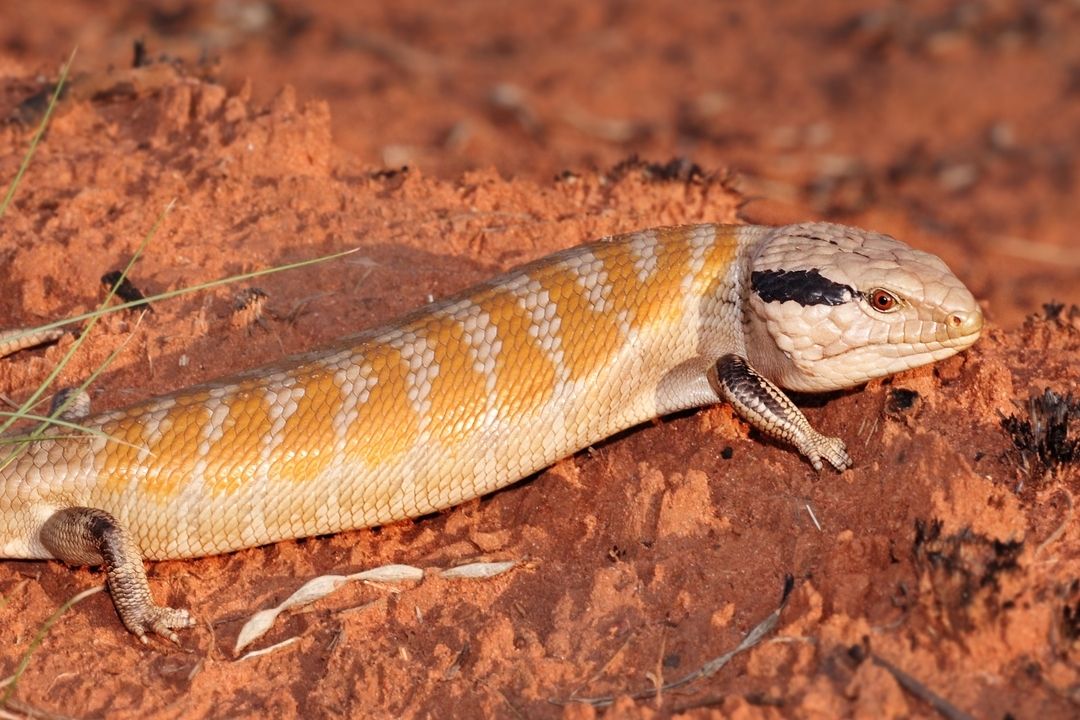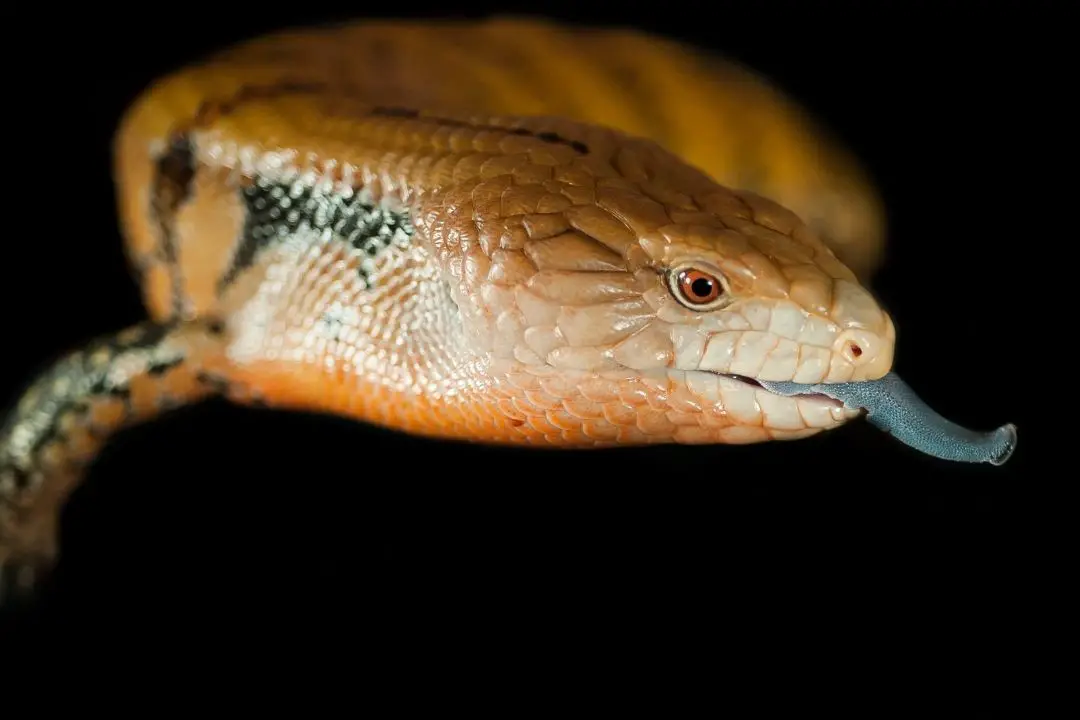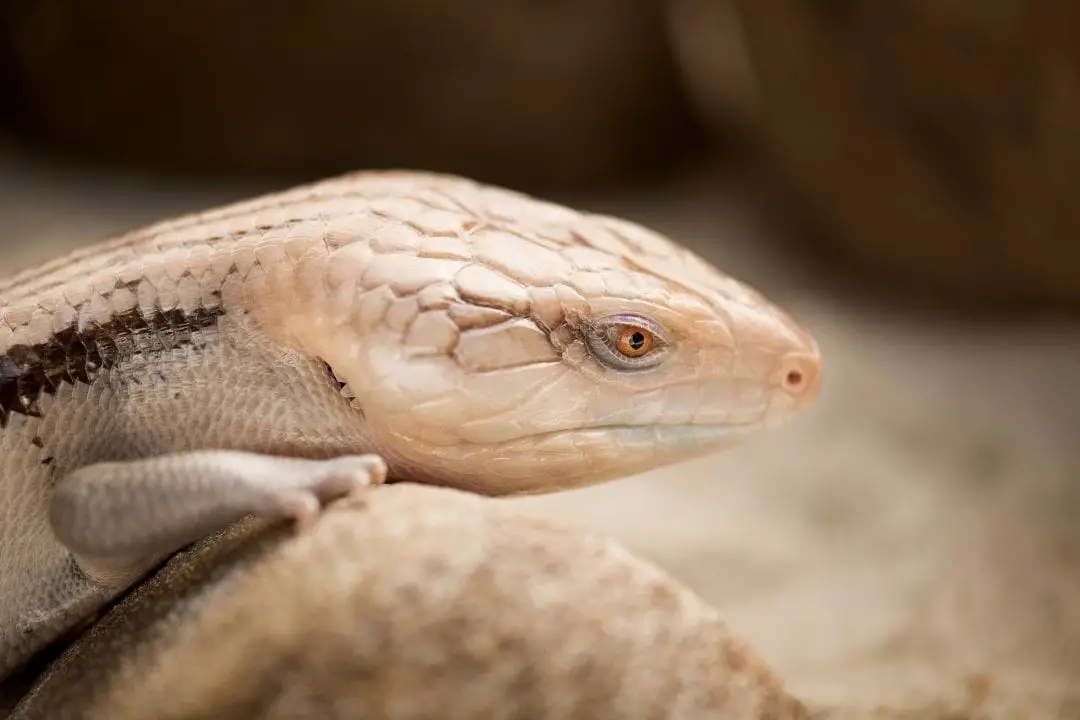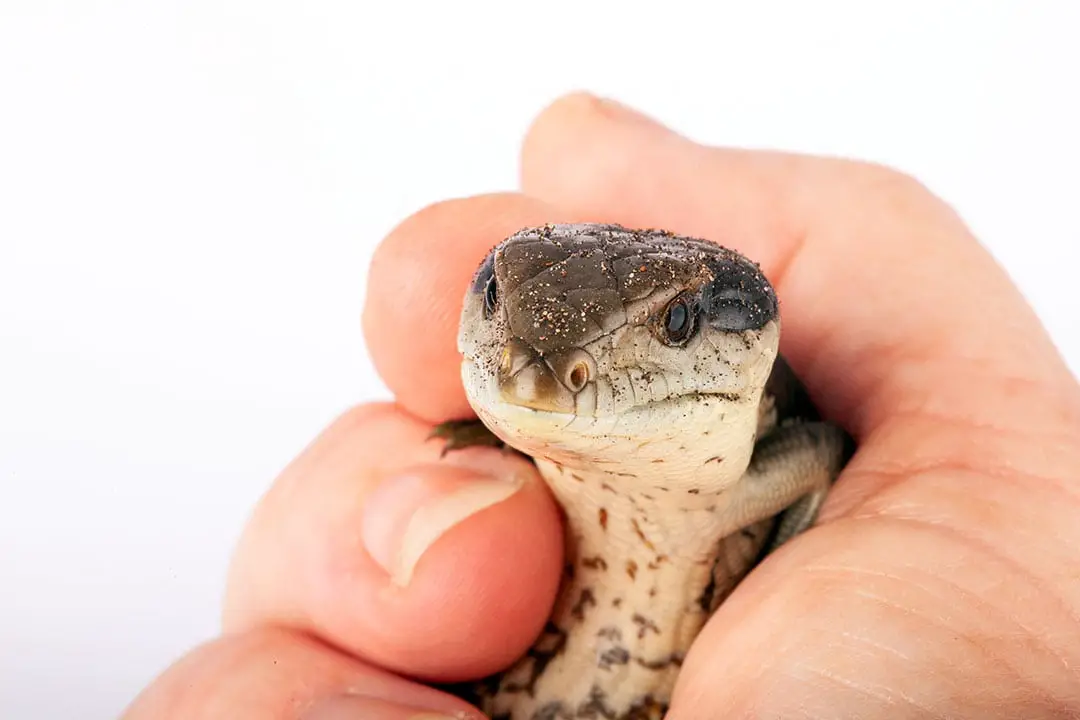Blue-tongued skinks are all members of the genus Tiliqua. They can be found in Australia and Indonesia.
Since these skinks are popular in captivity, they have been selectively bred for unique colors and patterns. These are called morphs.
I will be covering a few and noting what species they can be found in.
Some basics like amelanisitic or melanistic can be found in any species, so you can expect to see them in any animal with dark colors.
I will only be listing morphs. There are some other species of blue-tongued skink, but they are not unique color patterns.
1. T- Albino
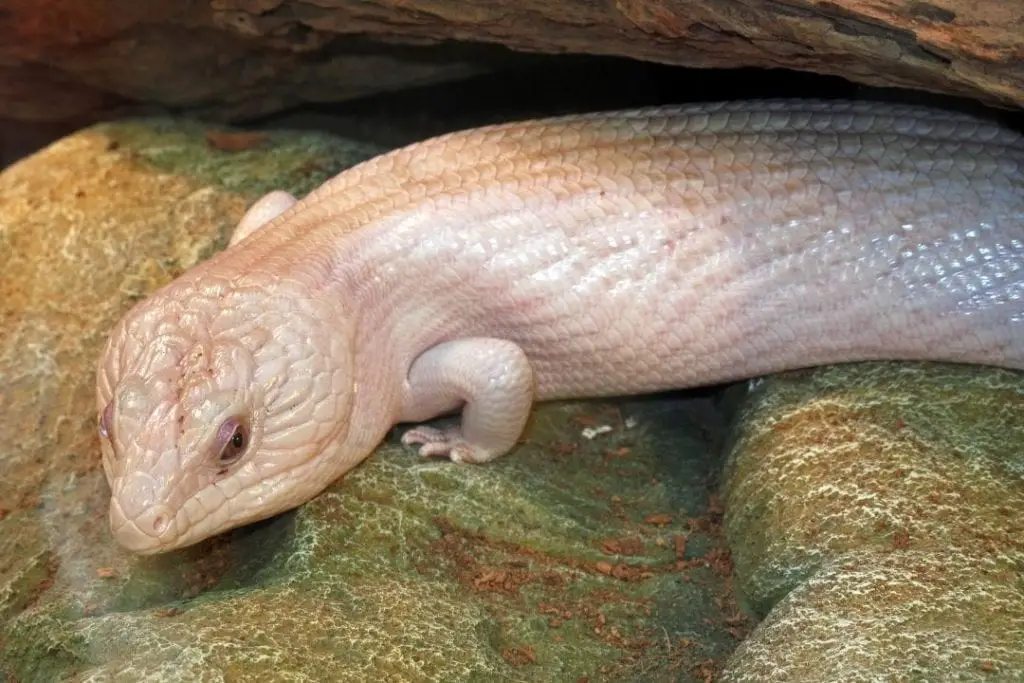
Albino blue-tongued skinks are also frequently called amelanisitic.
This is because it is caused by a lack of melanin. Albinism in mammals works a bit differently so it is frequently split when the topic is discussed.
This can be found in many of the Tiliqua species.
You will see the typical black portions of the pattern replaced with white, yellow, or caramel tones. A T- albino animal lacks the enzyme tyrosinase that helps metabolize melanin.
Animals that lack this will have pink or red eyes and may have some pink on their tongues. This is a simple recessive gene, so the animal will have two copies of the gene to have this morph.
You may see a het albino advertised, that just means that one of the animal’s parents was a visual albino. This is only useful if you intend to breed your skink.
This is mostly found in Australian species like the Northern and Eastern subspecies and rarely found outside of the country.
2. Anery and Axanthic
Anery is the short form commonly used to refer to animals that are anerythristic.
This refers to a lack of red pigment. Axanthic animals will be lacking the yellow pigment and frequently the red as well.
These animals will be black and white but retain the typical pattern for their species.
A pure anery will tend to look more yellow, but since these simple recessive morphs are so common together, you can find several appearances in the same litter.
They can have dark eyes and tongues.
Dark brown to black is accepted eye colors for the morph. Since the genes involved delete two of the major pigments for the animal, you can see anything from nearly white animals to nearly black that is all anery or axanthic.
Like the albino genes, anery is a major foundation for other morphs in the hobby. Since it is recessive, it combines well with other species.
You can find Indonesian and Halmahera blue-tongued skinks (Tiliqua gigas gigas) with this morph on rare occasions. This looks very similar to the line-bred black and gray animals, but true axanthic and anery have a different genetic cause.
3. Hypermelanistic
Hypermelanism is the opposite of amelanisim. Instead of lacking melanin, these skinks have more than usual.
This means that the normal black-colored areas of the animal will be expanded at a minimum and can even create a nearly fully black animal.
Since this is such a basic gene, you can find it for multiple species. While Indonesian species are captive-bred less often, you can still find the occasional morph.
Hypermelanism can be found as a line-bred trait or as a specific gene. In the Northern blue-tongued skink, this is considered to be a co-dominant trait.
A heterozygous or het animal will have more black than a wild-type while the homozygous or super form will frequently be pure black.
They can have either glossy or matte scales and may have a red belly. Since melanin levels can vary even in the wild, be sure you are only buying a captive-bred animal if you buy one of the Indonesian species.
The Australian species are illegal to export so you can only find captive-bred animals outside of Australia. You can also find melanistic examples of the Eastern blue-tongued skink (Tiliqua scincoides scincoides).
4. T+ Albino
T+ albino blue-tongued skinks are another form of albinism. They still have tyrosinase, so they have an altered appearance compared to T-.
They tend to have caramel or lavender tones that replaces their black. They tend to have a more yellow tone and some will retain some darker tones.
They tend to have darker eyes than the T- albino. This is also recessive just like the T- albino.
These two types of albinism will not mix. If you breed a T+ albino and a T- albino, the animal will appear normal but carry one copy of each type of albinism.
You could breed it with an animal that has either or both albinism genes to create a different look. This can be found in several of the species including Northern and Eastern blue-tongued skinks.
5. Super Hypo
Super hypo is a hypo melanistic gene that was created by crossing the Northern and Eastern subspecies.
They have the eye bands commonly found on the Eastern and the long head of the Northern.
They are typically very similar to the typical hypo if they carry one copy of the gene and are very white if they have two copies. This is a co-dominant gene.
There are a few lines of similar white pure Northern, but they are less common than the hybrid Super hypo.
6. Alabaster
The Alabaster morph uses hypomelanism and anery to create a pure white animal with dark eyes.
This is a double recessive combination. This combination is typically called ghost in other reptiles, but the original breeder Karen Russell preferred this name.
Some morphs like this may be found primarily in Australia, but you can sometimes find leucistic animals with a similar appearance in other countries.
For instance, several known co-dominant genes produce a white animal that may or may not have yellow banding.
7. Lava
Lava is the name for the recessive combination of breeding black and albino animals.
Thye can be orange with patches or white as babies.
This can be combined with other genes to create brighter colors in adults. Adults of this morph frequently end up being more of a brown tone, but it depends on the line and breeder.
8. Caramel
Caramel is a separate morph from the T+ albino.
They have a warm caramel brown with black banding.
This can be combined with T+ albino to create bright animals that lack black but have intense yellows, golds, and whites. Be sure to check what your specific animal is if you want this morph.
9. Sunset/Sunrise
Sunrise and sunset are frequently interchanged depending on the location and how the colors are distributed. These animals tend to have reduced blacks and more intense areas of orange and yellow.
They can be very pretty animals and they frequently keep at least some color as they age. Sunsets tend to have more dark tones and more orange over the body.
Sunrises tend to have more white or cream with bands of yellow or orange. This morph is only known in Northern blue-tongued skinks.
10. Magma
Magma is the name for blue-tongued skinks from James Fenn’s red line. This is not a gene so much as selective breeding for more intense red tones.
These animals can have a brick red color and may have reduced blacks. They are only found in Northern blue-tongued skinks, but any species can be bred for more red in their coloration.
11. Orange Line
Orange line animals are specifically bred to create brighter oranges. This is done simply by selecting the animals with the most orange coloration to breed for the next generation.
This is frequently bred with red and white lines to either intensify the color or dilute it to create an appearance similar to some strains of albinism.
Since these animals are just bred for color, there is no real guarantee that any offspring will also be more intense in color. Some animals in any litter will have more pigment while others will only be as bright as their parents at most.
12. White
When it comes to white animals outside of Australia, there are two general varieties. First, you have white line animals that are selectively bred for less coloration.
You may see the name of the breeder in the listing. This tends to be so people can help avoid inbreeding their animals. For instance, the breeder James Fenn has a line of selectively bred white animals.
There is something called Turner white. This might be a proper morph with a genetic cause, but it is still being tested at the time of writing. These animals tend to be lighter and fade as they age. They are somewhat uncommon and only a few breeders work with them.
13. Dark Line
Dark line animals are line bred for more black pigment. Most animals will not be solid black, but you can find some darker animals with ease.
Nice examples can have nearly solid black backs with bits of color on the side. Like other examples of line breeding, it is hard to predict what any offspring will look like.
Since it is not caused by a single gene, it can be hard to guarantee particularly dark animals in a single litter.
14. Pastel
Pastel animals are typically selectively bred for pale colors. You may see some animals called Swedish pastels, this refers to where the line originated.
This line can make other colors look more diluted, so they are frequently crossed with other lines to produce a look the breeder is aiming for.
Since it is also not caused by a single gene, it is unpredictable. It can take many generations to produce distinct animals.
15. Other Australian Morphs
Since it is possible to collect wild animals with unique looks in Australia, you will see the most interesting morphs and combinations in Australia.
There are combinations like snow, platinum, sunkissed, and purple found in Australia. These animals can be stunning. You can also find Eastern and Western blue-tongued skink morphs in the country.
There may be morphs found in the future for other Australian species as well. Most morphs are established from unusual-looking wild-caught animals.
A Quick Note on Blue-Tongued Skink Morphs
Many of the morphs on this list can only be found in Australia.
Since the passage of the Wildlife Protection (Regulation of Exports and Imports) Act of 1982 it has been illegal to export any native reptiles from Australia.
Some Northern blue-tongued skink morphs were discovered before exports were banned, but most were found after the law came into effect.
This is very true for the Eastern blue-tongued skink. Many of the morphs found in captivity were discovered in Australian animals after the law was passed.
This means that an animal that has a morph purchased outside of Australia may have been smuggled out or was bred from a smuggled animal.
This is a very legally gray area, so be careful of your local laws on such animals. Unless it has legal export papers from Australia, it could get you in trouble.
If you are concerned about an animal possibly being smuggled somewhere in its lineage, stick with line-bred animals or wild types.
Some animals are also hybrids of different Australian subspecies or were crossed with the Indonesian species.
Make sure you know what your new pet is since different species have different humidity needs at a minimum.
For a complete guide to enclosure setup, feeding, daily care and breeding,
check out my Blue-Tongued Skink Care Sheet
Most Indonesian species also do not have common morphs.
This is partly because so few breeders are working with these species. There may be morphs found in the future since it is legal to export animals from the region at the time of writing.
Conclusion
As you can see, blue-tongued skinks have some amazing color and pattern morphs.
If you want something beyond the typical wild-type animal, you have plenty of options.
If you have a favorite that wasn’t covered here, please share it in a comment down below.
